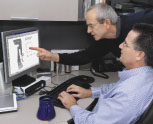Working Model 2D
2D Dynamic Motion Simulation

Working Model helps Life Fitness work out designs of exercise equipment
Just as health-conscious individuals use Life Fitness exercise equipment to work out muscles and build cardiovascular endurance, Life Fitness engineers use Working Model® 2D motion simulation software for exercising equipment on a computer, eliminating the need for physical prototypes. By working out designs in this way, Life Fitness is reducing the costs of physical prototyping, shortening design cycles and bringing high quality exercise equipment to market more quickly.
Life Fitness, a Brunswick Company, has been the world leader in commercial fitness equipment for nearly 20 years. In 1978, the company introduced the world’s first computerized exercise bike, the Lifecycle® exercise bike.
Its current product line includes the Life Fitness 9500 HR Cross-Trainer — Total Body System, Exertainment® interactive fitness system, along with traditional equipment such as treadmills, stairclimbers, rowers, and computerized and weightstack strength training systems. Life Fitness is registered to ISO 9001 international quality standards.
Life Fitness employs nearly 800 people worldwide, with headquarters in Franklin Park, Illinois. It sells its products primarily to large health and fitness clubs, and to consumers through retail stores and specialty fitness dealers.
Exercise Machine Mechanics
The company’s 35-member mechanical engineering department is responsible for design and analysis of its unique exercise equipment. Chuck Rosenow, a mechanical engineer, uses Working Model 2D v3.0 motion simulation software to design equipment without building physical prototypes.
Recently, Rosenow and his team completed development of the Cross-Trainer, a piece of exercise equipment that gives a total cardiovascular body workout through simultaneous movement of the arms and legs. According to Rosenow, Life Fitness unveiled the Cross-Trainer at two tradeshows on both coasts of the United States, and received rave reviews.
"I use Working Model to experiment with large numbers of simulations without building physical prototypes," he says. "Actually, analysis of the Cross-Trainer mechanism is complex so I wouldn’t have been able to design it without Working Model." In the past, it had taken over a year to finish a series of costly physical prototypes. Now, with Working Model, he can visualize and analyze dozens of different variations of mechanisms in two weeks.
Beginnings of the Cross-Trainer
As Rosenow began designing the Cross-Trainer, he focused on two elements an exerciser manipulates, the handlebars and the pedals. Rosenow first used Working Model to generate rough shapes for the major parts of the Cross-Trainer. Then, he produced linkages for these parts by connecting them with the Pin Joints tool in Working Model. Next, he used the Rigid Joint tool to establish bolted and welded joints. Last, he applied the Motor tool to the linkage and applied forces to simulate the exerciser. He also input the density for each of the links.
Up and Running
Once the model took shape, Rosenow then used AutoCAD® software from Autodesk, Inc., to draw the actual parts and create a detailed 2D drawing. He employed AutoCAD with a transparent interface to Working Model by using AutoMotion™ from Working Model, Inc. to export the CAD file into Working Model for simulation.
While running the simulation of the model, Rosenow used the Tracing tool to trace the motion of the handlebars and pedals. The Grid Function tool allowed Rosenow to quickly see if the motions of the handle bars and pedals were within the appropriate dimensions to provide effective, comfortable exercise.
While in Working Model, Rosenow chose the Measuring feature to show forces acting on any chosen pin joint at any particular moment during a simulation. For rigid joints, such as those that are bolted or welded, he analyzed them for torque and force. He also used the Slot tool to simulate a roller moving along a fixed path.
Rosenow appreciates the ability to click on "run" at any point while using Working Model to activate the simulation. Working Model’s graphics show the motion of the mechanism while the simulation runs. If there are errors in the model, such as an undefined pin joint, the simulation will quickly show the error.
Rosenow easily changed dimensions of the Cross-Trainer simulation model, such as length and location of links, to quickly run more simulations. He experimented with over 100 simulations to optimize the design.
Finite Element Analysis
To analyze stresses at the joints, Rosenow took force data from the simulation model, combined it with the geometry from the AutoCAD drawing, and imported the information into the Cosmos/m finite element analysis software from Structural Research & Analysis Corporation.
Then, he ran an analysis to ensure that the links could indeed handle the stresses placed on them by the exerciser. Once the overall design gained departmental approval, Rosenow used AutoCAD to generate detailed engineering drawings for manufacturing.
Pre-production Cross-Trainers underwent grueling 24-hour endurance testing to ensure that all parts of the machine met Life Fitness’s high standards for durability and reliability.
Working Model Essential to Cross-Trainer Design
"We couldn’t have achieved the design for the Cross-Trainer without Working Model," remarks Rosenow. "It enabled me to look quickly at over 100 linkage simulations without needing to build physical prototypes, greatly increasing our speed to market.
"Working Model is also a tremendous communications tool that I use for presentations to audiences who may not be familiar with technical aspects of exercise equipment," notes Rosenow. "I could show written equations to explain what I am calculating, but Working Model let’s me tell a better story with pictures. It’s been extremely useful for communicating to everyone — including staff in marketing, management, engineering, and design.
"Working Model’s intuitive object-oriented user interface makes it very easy to use. I can easily measure forces, torques and movements which is critical to my work. Also, the software is essential for the iterative work required in the design of exercise equipment.
"There’s no doubt that Working Model software has helped us to design the most durable, safe and effective Cross-Trainer for our customers, and will continue to help us with future products."

 Quote
Quote Evaluation
Evaluation



